Biosynthesis and Characterization of Silver Nanoparticles from Marine Macroscopic Red Seaweed Halymenia Porphyroides Boergesen (Crypton) and its Antifungal Efficacy Against Dermatophytic and Non-Dermatophytic Fungi
Objective: The current study illustrates the biosynthesis of economically scalable and energy efficient colloidal silver nanoparticles (AgNPs) from marine red seaweed Halymenia porphyroides Boergesen (Crypton) collected from Southeast coast of Tamil Nadu, India, and their antifungal efficacy against dermatophytic and non-dermatophytic fungi was evaluated.
Methods: The biosynthesis of silver nanoparticles from marine macroscopic red seaweed H. porphyroides Boergesen were synthesized by green synthesis method and characterized by UV–Vis spectroscopy, Fourier transform infrared (FT-IR) spectroscopy, X-ray diffraction, thermogravimetric analysis (TGA), scanning electron microscope (SEM), and transmission electron microscopy (TEM). The efficacy of silver nanoparticles against dermatophytic and non-dermatophytic fungi was performed by disk diffusion method.
Results: The presence of silver nanoparticles with an average size between 34.3 and 80 nm and exhibiting face-centered cubic structure was confirmed. SEM revealed the morphology of the nanoparticles as spherical and TEM exhibited the nanoparticle distribution. The FT-IR spectra confirmed the presence of potential biomolecules in the seaweed crude extract which is responsible for reducing and capping the bioreduced silver nanoparticles. The UV absorption spectra at 430.5 nm revealed the characteristic spectra of the silver nanoparticles. The purity and the thermal stability of silver nanoparticles were revealed by TGA. Silver nanoparticles showed significant efficacy against dermatophytes and Rhizopus microsporus among nondermatophytes.
Conclusion: Intermediate efficacy was observed against dermatophytes and among non-dermatophytic fungi R. microsporus exhibited better efficacy, whereas Aspergillus flavus were resistant to the biosynthesized silver nanoparticle.
Keywords: AgNPs, Biosynthesis, Halymenia porphyroides, Antifungal efficacy, Dermatophytes, non-dermatophytes.
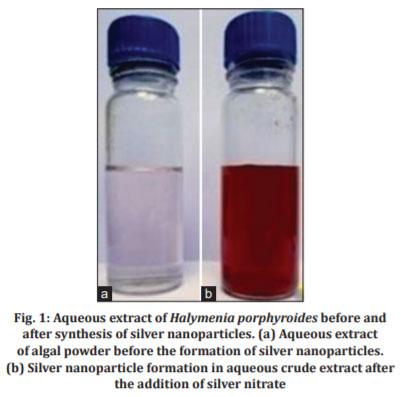
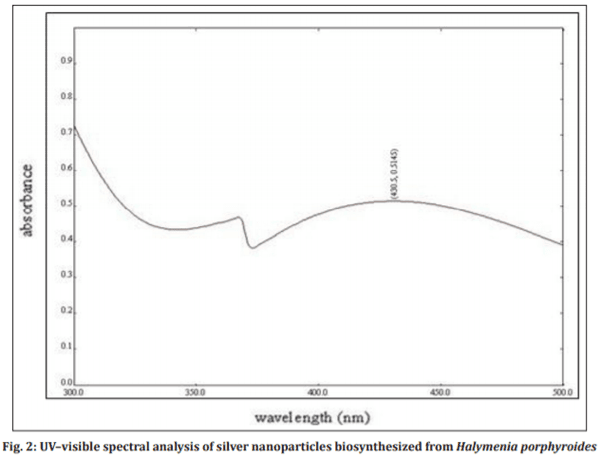
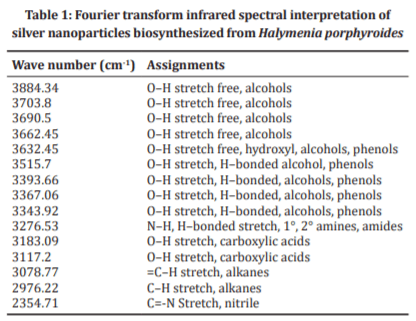
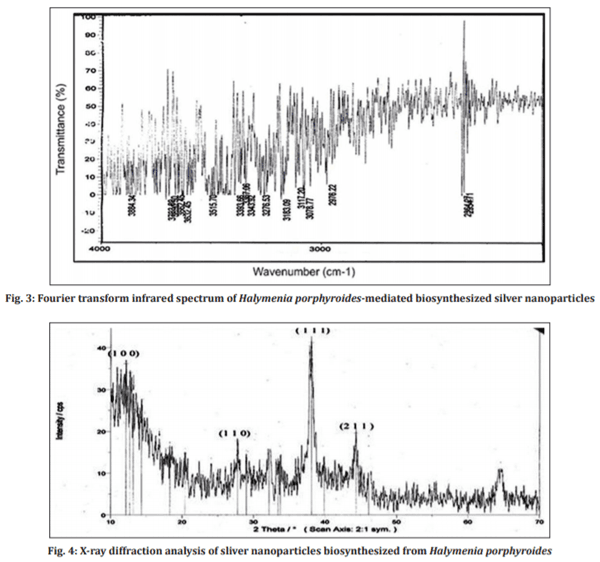
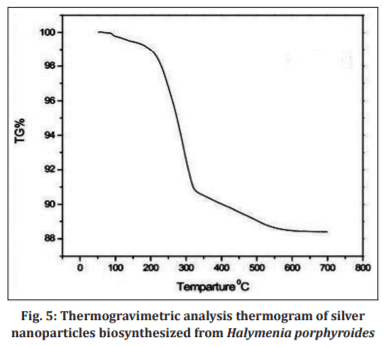
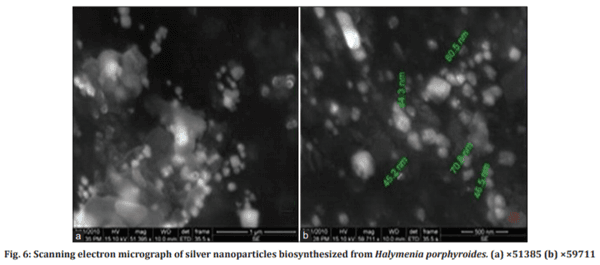


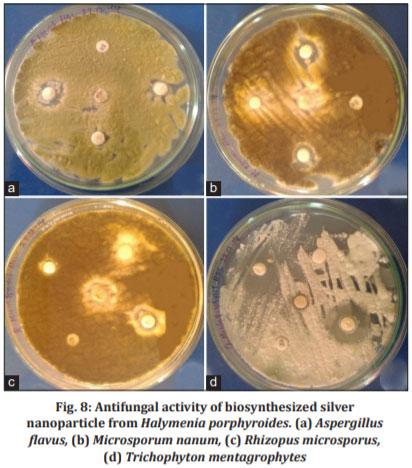
1. Prashant M, Nisha KR, Sudesh KY. Biosynthesis of nanoparticles: Technological concepts and future applications. J Nanopart Res 2008;10:507-17.
2. Saifuddin N, Wong CW, Nur Yasumira AA. Rapid biosynthesis of silver nanoparticles using culture supernatant of Bacteria with microwave irradiation. E J Chem 2009;6:61-70.
3. Alivisatos P. The use of nanocrystals in biological detection. Nat Biotechnol 2004;22:47-52.
4. Love JC, Estroff LA, Kriebel JK, Nuzzo RG, Whitesides GM. Self-assembled monolayers of thiolates on metals as a form of nanotechnology. Chem Rev 2005;105:1103-69.
5. Mirkin CA, Taton TA. Semiconductors meet biology. Nature 2000;405:626-7.
6. Nie S, Xing Y, Kim GJ, Simons JW. Nanotechnology applications in cancer. Annu Rev Biomed Eng 2007;9:257-88.
7. Wang MD, Shin DM, Simons JW, Nie S. Nanotechnology for targeted cancer therapy. Expert Rev Anticancer Ther 2007;7:833-7.
8. Daniel MC, Astruc D. Gold nanoparticles: Assembly, supramolecular chemistry, quantum-size-related properties, and applications toward biology, catalysis, and nanotechnology. Chem Rev 2004;104:293-346.
9. Goodsell DS. Bionanotechnology: Lessonsfrom Nature. New Jersey: Willey-Less; 2004. p. 1-8.
10. Chan WC, Nie S. Quantum dot bioconjugates for ultrasensitive nonisotopic detection. Science 1998;281:2016-8.
11. Tian Z, Ren B. Adsorption and reaction at electrochemical interfaces as probed by surface-enhanced Raman spectroscopy. Annu Rev Phys Chem 2004;55:197-229.
12. Klefenz H. Nanobiotechnology: From molecules to systems. Eng Life Sci 2004;4:211-8.
13. Kowshik M, Ashtaputre S, Kharrazi S. Extracellular synthesis of silver nanoparticles by a silver-tolerant yeast strain MKY3. Nanotechnology 2003;14:95-100.
14. Souza GI, Marcato PD, Duran N, Esposito E. Utilization of Fusarium oxysporum in the Biosynthesis of Silver Nanoparticles and its Antibacterial Activities. Brazil: Presented at 10th National Meeting of Environmental Microbiology; 2004. p. 25.
15. Duran N, Marcato PD, Alves OL, Souza G. Mechanistic aspects of biosynthesis of silver nanoparticles by several Fusarium oxysporum strains. J Nanotechnol 2005;3:8.
16. Sinha S, Pan I, Chanda P, Sen SK. Nanoparticle’s fabrication using ambient biological resources. J Appl Biosci 2009;19:1113-30.
17. Huang J, Li Q, Sun D, Lu Y, Su Y, Yang X, et al. Biosynthesis of silver and gold nano particles by novel sundried Cinnamomum camphora leaf. Nanotechnology 2007;18:105104-14.
18. Kiran MV, Murugesan S. Biosynthesis and characterization of silver nanoparticles from marine macroscopic brown seaweed Colpomenia sinuosa (Mertens ex Roth) Derbes and Solier. J Adv Chem Sci 2020;6:663-6.
19. Li H, Li F, Wang L, Shengv J, Xin Z, Zhao L. Effect of nanopacking on preservation quality of Chinese jujube (Ziziphus jujuba Mill. Var. inermis (Bunge) Rehd). Food Chem 2009;114:547-52.
20. Chaloupka K, Malam Y, Seifalian AM. Nanosilver as a new generation of nanoproduct in biomedical applications. Trends Biotechnol 2010;28:580-8.
21. Park HJ, Sung HK, Kim HJ, Choi SH. A new composition of nanosized silica-silver for control of various plant diseases. J Plant Pathol 2006;22:295-302.
22. Klaus T, Joerger R, Olsson E, Granqvist CG. Silver-based crystalline nanoparticles, microbially fabricated. Proc Natl Acad Sci U S A 1999;96:13611-4.
23. Konishi Y, Ohno K, Saitoh N, Nomura T, Nagamine S, Hishida H, et al. Bioreductive deposition of platinum nanoparticles on the bacterium Shewanella algae. J Biotechnol 2007;128:648-53.
24. Nair B, Pradeep T. Coalescense of nanoclusters and formation of submicron crystallites assisted by Lactobacillus strains. Cryst Growth Des 2002;2:293-8.
25. Willner I, Baron R, Willner B. Growing metal nanoparticles by enzymes. Adv Mater 2006;18:1109-20.
26. Shankar SS, Rai A, Ahmad A, Sastry M. Rapid synthesis of Au, Ag, and bimetallic Au core Ag shell nanoparticles using Neem (Azadirachta indica) leaf broth. J Coll Interf Sci 2004;275:496-502.
27. Kiran MV, Murugesan S. Biosynthesis and characterization of silver nanoparticles from marine macroscopic red seaweed Halymenia porphyroides Boergesen (Crypton). J Nanosci Tech 2020;6:886-90.
28. Kiran MV, Murugesan S. Biochemical investigation of marine seaweeds Colpomenia sinuosa and Halymenia porphyroides collected along south east coast of Tamil Nadu, India. Eur J Biomed Pharm Sci 2020;7:414-7.
29. Kiran MV, Murugesan S. Phytochemical, amino acid, fatty acid and Vitamin investigation of marine seaweeds Colpomenia sinuosa and Halymenia porphyroides collected along south east coast of Tamil Nadu, India. World J Pharm Res 2020;9:1088-102.
30. Kumar KA, Kumar SR, Rengasamy R. Review on bioactive potential in seaweeds (Marine Macroalgae): A special emphasis on bioactivity of seaweeds against plant pathogens. Asian J Plant Sci 2020;9:227-40.
31. Rajasulochana P, Dhamotharan R, Murugakoothan P, Murugesan S, Krishnamoorthy P. Biosynthesis and characterization of gold nanoparticles using the alga Kappaphycus alvarezii. Int J Nanosci 2010;9:511-9.
32. Swaminathan S, Murugesan S, Damodarkumar S, Dhamotharan R, Bhuvaneswari S. Synthesis and characterization of gold nano particles from alga Acanthophora specifera (VAHL) Boergesen. Int J Nanosci Nanotech 2011;2:85-94.
33. Dhamotharan R, Punitha D, Murugesan S, Subha TS. Brown algalbiomass mediated biosynthesis of gold nanoparticles. Int J Nanosci Nanotech 2010;1:37-44.
34. Pana CA, Milan K, Renata V, Robert P, Jana S, Vladimir K, et al. Antifungal activity of silver nanoparticles against Candida spp. Biomaterials 2009;30:6333-40.
35. El-Rafie MH, Mohamed AA, Shaheen TI, Hebeish A. Antimicrobial effect of silver nanoparticles produced by fungal process on cotton fabrics. Carbohydr Polym 2010;80:779-82.
36. Gogoi SK, Gopinath P, Paul A, Ramesh A, Ghosh SS, Chattopadhyay A. Green fluorescent protein-expressing Escherichi coli as a model system for investigating the antimicrobial activities of silver nanoparticles. Langmuir 2006;22:9322-8.
37. Roe D, Karandikar B, Bonn-Savage N, Gibbins B, Roullet JB. Antimicrobial surface functionalization of plastic catheters by silver nanoparticles. J Antimicrob Chem 2008;61:869-76.
38. Zeng F, Hou C, Wu SZ, Liu XX, Tong Z, Yu SN. Silver nanoparticles directly formed on natural macroporous matrix and their anti-microbial activities. Nanotechnology 2007;18:1-8.
39. Kim KJ, Sung WS, Moon SK, Choi JS, Kim JG, Lee DG. Antifungal effect of silver nanoparticles on dermatophytes. J Microbiol Biotech 2008;18:1482-4.
40. Monali G, Jayendra K, Avinash I, Aniket G, Mahendra R. Fungusmediated synthesis of silver nanoparticles and their activity against pathogenic fungi in combination with fluconazole. Nanomed Nanotech Biol Med 2009;5:382-6.
41. Finegold SM, Baron EJ. Bailey and Scotts Diagnostic Microbiology. 7th ed. St. Louis: The C.V. Mosby Company; 1986.
42. NCCLS. Method for Antifungal Disk Diffusion Susceptibility Testing of Yeasts; Approved Guideline. Pennsylvania: NCCLS; 2004. p. 19087.
43. Rajesh KS, Malrakodi C, Venkat KS. Synthesis and characterization of silver nanoparticles from marine brown seaweeds and its antifungal efficiency against clinical fungal pathogens. Asian J Pharm Clin Res 2017;10:190-3.
44. Henglein A. Physicochemical properties of small metal properties in solution: Micrelectrode reactions, chemisorption’s, composite metal particles and the atom to metal transistion. J Phys Chem 1993;97:5457-71.
45. Kumar P, Senthamilselvi S, Prabha AL, Kumar KP, Kumar RS, Govindaraju M. Synthesis of silver nano particles from Sargassum tenerrimum and screening phytochemicals on its antibacterial activity. Nano Biomed Eng 2012;4:12-6.
46. Sastry M, Patil V,Sainkar SR. Electrostatically controlled diffusion of carboxylic acid derivatized silver colloidal particles in thermally evaporated fatty amine films. J Phys Chem B 1998;102:1404-10.
47. Silverstein RM, Webster FX. Spectrometric Identification of Organic Compounds. New York: John Wiley & Sons; 1998.
48. O’Coinceanainn MO, Astill C, Schumm S. Potentiometric FTIR and NMR studies of the complexation of metals with theaflavin. Dalton Trans 2003;5:801-7.
49. Inbakandan D, Venkatesan R, Khan A. Biosynthesis of gold nanoparticles utilizing marine sponge Acanthella elongata (Dendy, 1905). Colloids Surf B Biointerfaces 2010;81:634-9.
50. Sathyavathi R, Krishna MB, Rao SR, Saritha R, Rao DN. Biosynthesis of silver nano particles using Coriandrum sativum leaf extract and their application in nonlinear optics. Adv Sci Lett 2010;3:1-6.
51. Rashmi S, Preeti V, Sadhna P. Enzymatic formation of gold nanoparticles using Phanerochaete chrysosprium. Adv Chem Eng Sci 2011;1:154-62.
52. Chen Q, Liu G, Chen G, Mi T, Tai J. Green synthesis of silver nanoparticles with glucose for conductivity enhancement of conductive ink. Bioresources 2016;12:608-21.
53. Zavoi S, Fetea F, Ranga F, Pop R, Baciu R, Socaciu C. Comparative fingerprint and extraction yield of medicinal herb phenolics with hepatoprotective potential, as determined by UV-Vis and FT-MIR spectroscopy. Not Bot Horti Agrobot Cluj Napoca 2011;39:82-9.
54. Leff DV, Brandt L, Heath JR. Synthesis and characterization of hydrophobic, organically soluble gold nanocrystals functionalized with primary amines. Langmuir 1996;12:4723-30.
55. Paneerselvam C, Ponarulselvam S, Murugan K, Kalimuthu K, Thangamani S. Synthesis of silver nanoparticles using leaves of Catharanthus roseus Linn. G. Donn and their antiplasmodial activities. Asian Pac J Trop Biomed 2012;2:574-80.
56. Chandra DA, Kumar SS.Mycogenic silver nanoparticle biosynthesis and its pesticide degradation potentials. Int J Tech Enhanc Emer Eng Res 2015;3:108-13.
57. Daizy P. Biosynthesis of Au, Ag and Au-Ag nanoparticles using edible mushroom extract. Spectrochimic Acta Part A 2009;73:374-81.
58. Bajpai SK, Mohan YM. Recent Advances in Nanoscience and Technology. Dubai: Bentham Science Publishers; 2009.
59. Assael ML, Gialou K. Measurement of the thermal conductivity of stainless steel AISI 304 L up to 550 K. Int J Therm Phys 2003;24:1145-53.
60. Ananth AN, Umapathy S, Sophia J, Mathavan T, Mangalaraj D. On the optical and thermal properties of in situ/ex situ reduced Ag NP’s/ PVA composites and its role as a simple SPR-based protein sensor. Appl Nanosci 2011;1:87-96.
61. Mbhele ZH, Salemane MG, van Sittert DG, Nedeljkovic JM, Djokovic V, Luyt AS. Fabrication and characterization of silverpolyvinyl alcohol nano composites. Chem Mater 2003;15:5019-24.
62. Xu B, Qian L, Liu X, Song C, Yan Z. Synthesis and characterization of magnesium substituted aluminophosphate molecular sieves with AEL structure. J Nat Gas Chem 2004;13:231-7.
63. Yu-Yuan S, Sun B, Zhou Z, Yong-Tao W, Mei-Fang Z. Size-controlled and large-scale synthesis of organic-soluble Ag nanocrystals in water and their formation mechanism. Prog Nat Sci Mat Int 2011;21:447-54.
64. Smith A. Particle Growth in Suspensions. London: Academic Press; 1983. p. 3-15.
65. Forough M, Farhadi K. Biological and green synthesis of silver nanoparticles. Turk J Eng Environ Sci 2010;34:281-7.
66. Amjad H, Jamaroz K, Muhammad FK. Synthesis and characterization of antimicrobial polymer containing silver nano particles. Pak Oral Dent J 2012;32:539-49.
67. Dhandapani P, Supraja N. Extracellular synthesis of silver nano particles by marine thermophilic Bacteria. Int J Pharm Biol Arch 2012;3:1418-23.
68. Chandran SP, Chaudhary M, Pasricha R, Ahmad A, Sastry M. Synthesis of gold and silver nano particles using aloe vera plant extract. J Biotechnol Prog 2006;22:577-83.
69. Crawford BJ, Burke RD. TEM and SEM methods. Cell Biol 2004;74:411-41.
70. Jiang ZJ, Liu CY, Sun LW. Catalytic properties of silver nanoparticles supported on silica spheres. Am Chem Soc 2004;62:4459-63.
71. Ahmad A, Mukerjee P, Senapati S, Mandal D, Khan MI, Kumar R. Extracellular biosynthesis of silver nano particles using the fungus Fusarium oxysporum. Colloids Surf B 2003;28:313-8.
72. Murugesan S, Elumalai M, Dhamotharan R. Green synthesis of silver nanoparticles from marine alga Gracilaria edulis S.G (Gmelin) P.C. Silva. Biosci Biotech Res Commun 2011;4:105-10.
73. Shipway AN, Katz E, Willer I. Nano particle arrays on surfaces for electronic, optical and sensor applications. Chem Phys Chem 2000;1:18-52.
74. Raghunandan D, Basavaraja S, Mahesh B, Balaji S, Manjunath SY, Venkataraman A. Biosynthesis of stable poly shaped gold nano particles from microwave-exposed aqueous extracellular anti-malignant guava (Psidium guajava) leaf extract. Nano Biotechnol 2009;5:34-41.
75. Noruzi M, Zare D, Khoshnevisan K, Davoodi D. Rapid green synthesis of gold nano particles using rosa hybrid petal extract at room temperature. Spectrochimica Acta Part A 2011;79:1461-5.
76. Alt V, Bechert T, Steinruecke P, Wagener M, Seidel P, Dingeldein E, et al. An in vitro assessment of the antibacterial properties and cytotoxicity of nanoparticulate silver bone cement. Biomaterials 2004;25:4383-91.
77. Shafaghat A. Synthesis and characterization of silver nanoparticles by the phytosynthesis method and their biological activity. Synth React Inorg Metal Org Nano Metal Chem 2015;45:381-7.
78. Kim J, Lee J, Kwon S, Jeong S. Preparation of biodegradable polymer/ silver nanoparticles composite and its antibacterial efficacy. J Nanosci Nanotechnol 2009;9:1098-102.
79. Ahmed RH, Mustafa DE. Green synthesis of silver nanoparticles mediated by traditionally used medicinal plants in Sudan. Int Nano Lett 2020;10:1-14.
80. Anupam R, Onur B, Sudip S, Amit KM, Yilmaz MD. Green synthesis of silver nanoparticles: Biomolecule-nanoparticle organizations targeting antimicrobial activity. RSC Adv 2019;9:2673-702.
81. Anes AS, Kasing A, Micky V, Devagi K, Lesley MB. Enhancement of antibacterial activity of silver nanoparticles against gram positive and gram negative using blue laser light. Int J Photoene 2019;2019:1-12.
82. Sunita P, Rajeshwari S, Rajiv P, Rajendran V, Seenivasan R. Green synthesis of silver nanoparticle from leaf extract of Aegle marmelos and evaluation of its antibacterial activity. Int J Pharm Pharm Sci 2015;7:169-73.
83. Vivek VA, Subhash N, Shakilabanu A, Gino AK. Characterization and biological evaluation of silver nanoparticles synthesized by aqueous root extract of Desmodium gangeticum for its antioxidant, antimicrobial and cytotoxicity. Int J Pharm Pharm Sci 2014;7 Suppl 1:182-6.



